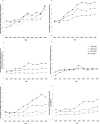Trends in antibiotic prescribing in adults in Dutch general practice
- PMID: 23251643
- PMCID: PMC3520879
- DOI: 10.1371/journal.pone.0051860
Trends in antibiotic prescribing in adults in Dutch general practice
Abstract
Background: Antibiotic consumption is associated with adverse drug events (ADE) and increasing antibiotic resistance. Detailed information of antibiotic prescribing in different age categories is scarce, but necessary to develop strategies for prudent antibiotic use. The aim of this study was to determine the antibiotic prescriptions of different antibiotic classes in general practice in relation to age.
Methodology: Retrospective study of 22 rural and urban general practices from the Dutch Registration Network Family Practices (RNH). Antibiotic prescribing data were extracted from the RNH database from 2000-2009. Trends over time in antibiotic prescriptions were assessed with multivariate logistic regression including interaction terms with age. Registered ADEs as a result of antibiotic prescriptions were also analyzed.
Principal findings: In total 658,940 patients years were analyzed. In 11.5% (n = 75,796) of the patient years at least one antibiotic was prescribed. Antibiotic prescriptions increased for all age categories during 2000-2009, but the increase in elderly patients (>80 years) was most prominent. In 2000 9% of the patients >80 years was prescribed at least one antibiotic to 22% in 2009 (P<0.001). Elderly patients had more ADEs with antibiotics and co-medication was identified as the only independent determinant for ADEs.
Conclusion/discussion: The rate of antibiotic prescribing for patients who made a visit to the GP is increasing in the Netherlands with the most evident increase in the elderly patients. This may lead to more ADEs, which might lead to higher consumption of health care and more antibiotic resistance.
Conflict of interest statement
Figures



References
-
- Kuyvenhoven MM, van Balen FA, Verheij TJ (2003) Outpatient antibiotic prescriptions from 1992 to 2001 in the Netherlands. J Antimicrob Chemother 52: 675–678. - PubMed
-
- Norris P, Horsburgh S, Keown S, Arroll B, Lovelock K, et al. (2011) Too much and too little? Prevalence and extent of antibiotic use in a New Zealand region. J Antimicrob Chemother 66: 1921–1926. - PubMed
-
- Pan A, Buttazzi R, Marchi M, Gagliotti C, Resi D, et al. (2011) Secular trends in antibiotic consumption in the adult population in Emilia-Romagna, Italy, 2003–2009. Clin Microbiol Infect 17: 1698–1703. - PubMed
-
- Feldman C (2001) Pneumonia in the elderly. Med Clin North Am 85: 1441–1459. - PubMed
MeSH terms
Substances
LinkOut - more resources
Full Text Sources
Medical
Miscellaneous

